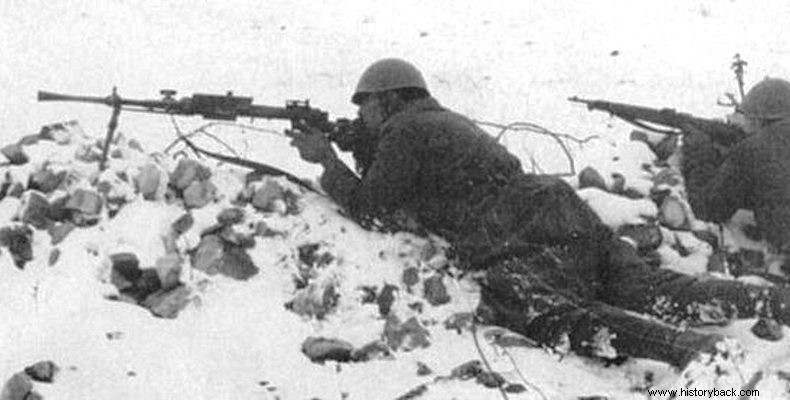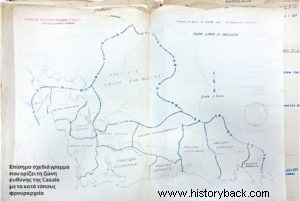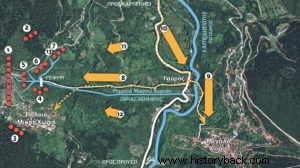
Rastrellare in Italian means combing, clearing. For such a liquidation operation (rastrellamento), codenamed "Operazioni K", on December 3, 1942, several reinforced phalanxes bearing the names of their commanders (Brancaccio, Valentino, Crocella, Piras and Bottini). The phalanxes belong to three different divisions that are intended to surround Eurytania from the North (Modena), from the Northeast (Pinerolo) and from the West-Southwest (Casale).
OF THE MONTH
SOURCE:NEWSPAPER OF THE EDITORS
The bang of the Gorgopotamos blast is so loud that it forces the High Command of the Regio Esercito (Italian Royal Army) to take drastic measures. The information speaks of rebel groups threshing in the area and indeed of groups that operated in Gorgopotamos. Thus, their exemplary extermination is deemed imperative. General Mario Maggiani of Casale takes over the direction of the operation from Agrinio, especially Aetoloakarnania, large parts of Evrytania, Phocis, and Arachova are his "territory".
In this article we will follow the course and in particular the action of the Bottini phalanx, which dynamically sets out from the large base of Casale to Agios Vlasios Trichonidas. Colonel Armando Bottini is the commander of the 12th Regiment. The phalanx that bears his name is made up of two strong divisions. The first is the II/12th battalion reinforced with a platoon of 81mm mortars and a "team" of 2 47/32 guns.
The second, under the command of 1o Seniore [1] Consonni, consisted of 2 companies of the XXVI Blackcoat Battalion, 2 companies of the I/11th Battalion, a machine gun platoon and a 81mm mortar platoon. Total strength of the entire phalanx, 45 officers and 970 hoplites with 274 subs. The route they will follow is as follows:Agios Vlasios-Episkopi-Kerasovo and on December 5, approaching 2 km outside of Chrysos, they will get the first taste of the guerrilla rifle. Captain Ermis (Vassilis Priovolos) of the Evrytania Headquarters, in an adventurous way and with only 28 rebels, will escape from the Italian cordon and will be the first to reach the narrows of Souila, at the entrance of the village.
So when the advance guards of the phalanx approach, they receive a barrage of fire and retreat leaving behind 2 dead and 11 wounded. On December 6th the Italians will remain outside Chrysos and will execute 2 hostages and 5 arrested rebels. Finally, on December 7, with a thousand precautions, they will enter the deserted village and set it on fire. On December 8, the phalanx will continue its march and reach Myrisi. The next day in Paramerita and on December 10th he will enter the deserted Agrafa, which will also be given over to the flames.
One day later he will return to Chrysos, from there via Viniani on December 13, at 4 pm, he will enter Karpenisi for regrouping and rest. On the day that Chrysos was set on fire, another phalanx (around 200 rebels) led by Aris Velouchiotis and the newcomer from Athens Lefteria (Vangelis Papadakis) entered the old Giannitsou Fthiotida. It consisted, in one body, of what would soon be called the Headquarters of Fthiotida and Parnassida.
At the entrance of the village, with their captain Nakos Belis amiably twirling his curly moustache, they will be impressively greeted by the rebels of the Domokos Headquarters (about 130), lined up in a double row, dressed almost uniformly wearing black fur caps instead of two, loot by the "Legionaries of the Principality" [2] , who with great success exterminated. The atmosphere is festive. Three months ago, when Velouchiotis "descended" to Giona, he had only a dozen rebels, while Belis had not even ten.
The satisfaction is widespread and the gunpowder-smoked winners of Gorgopotamos together with the enthusiastic Domokites will start, the next day, for Evrytania. Their course is:Nea Giannitsou-Tsouka-Sperchios-Fteri-Gardiki Omilaion. During its duration, their number is constantly increasing from new ranks with a typical example being that of Pope Kostas Tzevelekas from Kolokythia, the heroic Papakoumboura.
In Gardiki, on December 14, the general meeting of almost 400 rebels will take place. A 5-member headquarters, a 15-member coordinating body will be elected and it will be decided to pursue the group of deserters Geka-Varda as well as the "tour" of the rebels to Epirus to meet Zervas. The march will continue towards Pugakia-Krikello and on the 17th they will camp in Mikro Chorio. The fog-covered cold morning of December 18 will find the Consonni Phalanx [3], at 8 o'clock precisely, setting out in the direction of Prussia to "comb", according to the planning of the operation, that particular area.
On the other hand, the guerilla section was enjoying, after a hearty breakfast, some rare moments of rest, which were however violently interrupted as the panting link of Koutsoyennes came from Megalo Chorio bringing the news. The lookouts detected a large Italian phalanx approaching Gavros. There was a disturbance. In a hasty meeting of Ares with Lefterias and Belis, it was decided to strike the enemy. Civilians began to climb towards Helidona, while the rebels ran to take positions.
Two groups [4] of Parnassis and two of Domokos took up positions on the heights behind the stone bridge that surrounds Xirias, the stream that flows through the ravine parallel to the dirt road that joins the Mikro to the Megalo Chorio (see map of the battle). . Commander of the arrangement - who else? - the trusted and efficient Nikiforos (Dimitrios N. Dimitriou) who with a group from Parnassis "caught" the left bank of the river.
The self-proclaimed 6th Domokite Group of captain Othry (Giorgos Douatzis) camped even further to the left, next to Nikiforos, on the dry slope that the locals call Tsiri. On the right bank and a little higher the position was occupied by the other group of Parnassis, led by Lambro-Pelopidas. Finally, the other group of Domokos with Nikiforos (teacher N. Karkanis) lined up even further to the right. A horseshoe was thus formed which was intended to trap as many attackers as possible in the gully. Ares kept the main force, as a reserve, in order to deliver, at the right moment, the decisive blow.
The fighters drummed up as best they could and with their finger on the trigger they stared nervously towards Megalo Chorio. Indeed at 11.45 the Italian phalanx was seen entering the Megalo Chorio, while a large part of it entered the ravine in the direction of the Mikro Chorio. It was the entire II/12 that, with the vanguard of the 6th Company, was getting closer and closer to the bridge, with its captain Werther Marvelli in front and at the same time in the sights of Nikephoros' Arabida. He was walking, uphill, without any protection, not a scout in front of him, and every now and then he stopped to catch his breath.
And while everything seemed to be going according to plan, inexplicably Marvelli turned his company to the left and began to climb a path that led to the first houses on the eastern side of the village. Nikephoros, surprised, weighed the situation and in order to completely lose the Italians from his field of vision fired the first shot knocking down the leading Marvelli. An inferno of fire immediately erupted, pinning down the advance division that was desperately looking for ways to take cover. This is where the Italians suffered the greatest losses. Chaos prevailed for a quarter of an hour.
II/12, however, was a battle-experienced battalion that slowly began to come together. The machine guns and especially the mortars began to set up creating a base of fire and the remaining companies regrouped and moved slowly but steadily towards the guerrilla positions. And while the fire of the defenders began to thin out, due to the constant lack of ammunition, the Italian fire intensified and, worst of all, the fire of the heavy mortars from Megalo Chorio also joined the dance. The exchange of fire continued for about an hour. The burden of the attack was borne mainly by the two teams, Nikiforos and Othry.
At 12.45 the situation worsened when a company of XXXVI from the left and one of I/11 from the right moved to outflank the guerrilla formation. Ares weighed the situation and signaled [5] the unhooking of all sections. The retreat was organized and gradual. The only ones who remained in their places were Nikephoros and three young Domicites who were lying on the ground to his left. They did not notice the blasts as they were beside a rushing stream, receiving a storm of fire.
In the end, in a cinematic way, they also joined [6] with their companions, but leaving behind the youngest (17 years old) of the three Kostas Birtsa (Klearchos), from Perivlepto Fthiotida, dead. The slogan-counter-slogan "Klearchos-Mikro Chorio" will be heard, throughout the Occupation, at the lookouts of the rebels of Roumeli. At 14.45 and with a thousand precautions, the Italians entered Mikro Chorio. They took hostages and of course set fire to the village.
In the report made, the rebels count one dead and four slightly wounded. The Italians on their side have 10 dead and 30 wounded. Among the wounded were Captain Marvelli and Lieutenant Berti [7], the latter succumbing to his wounds 9 days later. The next day the guerrilla force was far away undisturbed at Fidakia, continuing its march towards Epirus, while the numbed Italians continued their clearing operations towards Prussos. But they will return more fiercely on December 24 and burst into the hostages, executing them ([8] .
The battle in Mikro Chorio is the first confrontation of a guerrilla unit with more than twice the enemy force equipped with heavy weapons, in an open battlefield. Rebels do not retreat at the sight of an organized army. They treat him as an equal. They pin him down, cause him casualties and retreat in an orderly fashion when deemed necessary. After the battle, the reputation of ELAS soared and volunteers enlisted en masse, while the Italians realized with horror that in the mountains of occupied Greece, the guerrilla army now has the first say.
Explanations
[1] Rank of the Blackcoats equivalent to lieutenant colonel.
[2] Vlach-speaking separatists who cooperated with the Italian forces.
[3] Botinni, on December 14, will be urgently summoned to Athens when the entire phalanx it will now be called the Consonni Phalanx.
[4] 15 men strong each.
[5] The signal for retreat was given with the trumpets sounding convincingly to "advance", as had been agreed.
[6] Nikephoros an hour or two later and the two Domokites (Atromitos and Leo) at midnight.
[7] This is the only officer who was ultimately killed in battle. Marvelli recovered and returned to the unit in March 1943. In conclusion, there was no dead lieutenant colonel, just as there never was an Italian regiment of Karpenisi.
[8] 13 hostages from Mikro and Megalo Chorio. The two (the priest Dim. Vastakis and the priest Har. Katsimbas) were burned after being trapped in a house that was set on fire. The remaining 11 will be executed at Longoves.
Bibliography
1. Dimitrios N. Dimitriou:Rebel in the mountains of Roumeli.
2. Panos Lagdas:Aris Velouchiotis:the first of the match.
3. History of the National Resistance 1941-1944. Renaissance Editions.
4. Archivo Ufficio Storico. Stato Maggiore Esercito.
Diario Storico Divisione Casale, Bimestre Novembre-Decembre 1942.
Diario Storico 12 RGT, Bimestre Novembre-Decembre 1942.
Diario Storico XXXVI Btg CC.NN Ciclisti, Trimestre Ottobre- November-December 1942.
5. Pier Paolo Battistelli Piero Crociani:Le Camicie Nere 1935-1945.


THIS TEXT IS PUBLISHED EXACTLY AS IT IS WITHOUT ANY CHANGES. THE ARTICLE EXPRESSES THE WRITER. THE PAGE DOES NOT CENSOR ANYONE AS LONG AS IT REMAINS WITHIN THE FRAMEWORKS OF BEAUTY.
